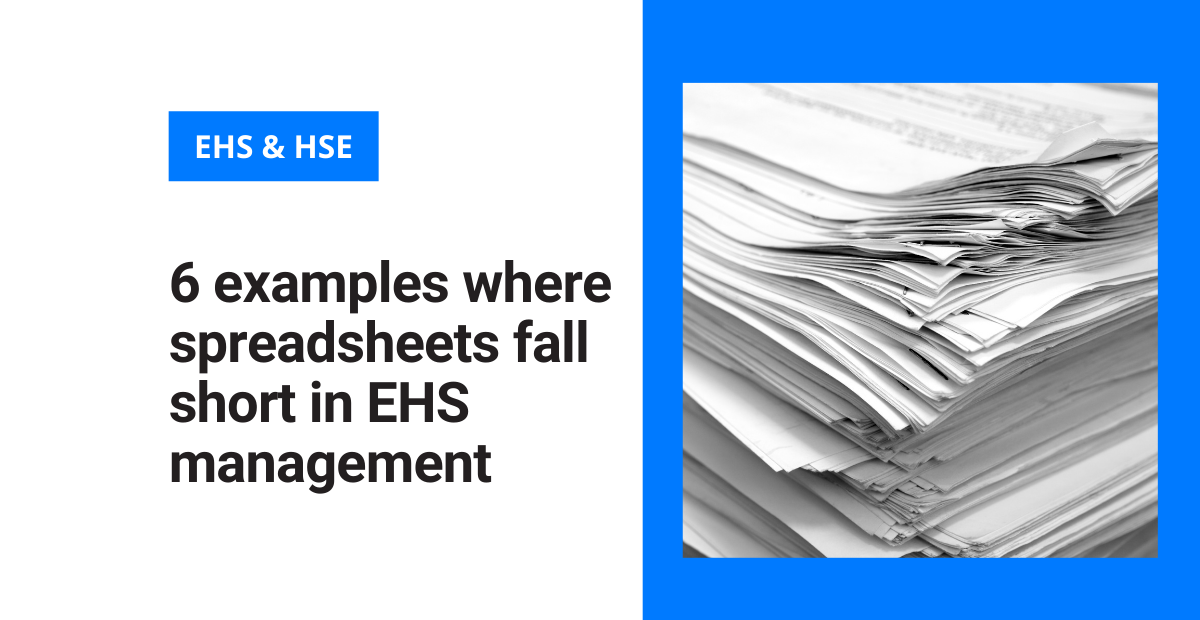Using spreadsheets in EHS management can be extremely effective for meeting performance goals. But are they as efficient as you need them to be? Below are 6 different examples where spreadsheets could be restricting you from exceeding your productivity potential.
Safety culture
Every research, article, and piece of content on building a safety culture in the workplace underlines the importance of engaging, communicating, and collaborating with employees. So what does this have to do with spreadsheets? On average, safety managers using manual methods such as spreadsheets spend 20 hours more per week with documentation compared to safety managers using EHS management software.
By getting 20 hours of their workweek back, safety leaders can take the time to go out on the field, interact with employees, and address any questions or concerns regarding safety. A strong safety culture comes with practicing what you preach and being a visible example to the workforce. That’s hard to do when the best person for the job is stuck behind the desk completing admin duty.
Reliability
Data shows that 88% of spreadsheets have errors. We hope you are among the lucky 12% but in any case, even the most carefully documented sheet is prone to human error. The smallest typo in a formula can lead you to misinterpret the safety statistics of your workplace. Also, Excel isn’t the best platform for collaborative work. With multiple people making multiple edits to the document, an important piece of information is sure to get lost in translation.
There’s also the risk of security. Excel files don’t really have a restriction on who can access the file and the data inside can easily change. Losing data or letting it fall into the wrong hands can be costly for the workplace. Check out this example of how a simple spreadsheet error cost TransAlta a whopping $24M.
Ensuring compliance
There’s no denying the fact that spreadsheets are super useful. But how do they help you keep up with regulation changes or help monitor the changes happening in your workplace? Surely there are templates like change management logs, change impact assessment, or change request forms to simplify processes. But setting up, tracking, and signing off all these different documents along with training can take up to 120 hours of work. If your workplace is covered under PSM, the risks are too high to depend on manually entered data.
Being prepared for EHS audits or inspections also comes with its difficulties. Pulling up the specific data you need at any given time can end up requiring complicated formulas and functions. To add, monitoring environmental impacts such as waste management or carbon emissions is extremely difficult when using Excel.
Employee collaboration
We mentioned the importance of employee collaboration. Let’s look at near misses as an example. Ideally, employees should report any type of near-miss they encounter. Say a loose piece of clothing gets stuck in a machine but doesn’t do any damage. Can spreadsheets help increase the probability of this incident being reported? The odds can increase by simplifying the reporting process, making it more accessible, and ensuring anonymity.
No matter how simple the form is, employees may avoid the hassle of filling it out, disregard important details to keep it short, or might simply forget to report the incident by the time they are back at the office. Using EHS software with a mobile app feature can push participation and increase near-miss reporting, which then helps identify potential incidents and proactively assign corrective actions to address and correct these issues.
On-the-go access
Capturing real-time data is critical when it comes to safety. Of course, you can have your spreadsheet open on your iPad or phone and document any data you come across as you conduct your daily walkaround. But it would be bold to say that Excel is mobile-friendly.
This static tool can hold you back from getting the information you need, fast. When dealing with chemical manufacturing or any hazardous materials, real-time and offline access information such as chemical inventory, SDSs, and dangerous wastes can significantly improve hazard determination and the protective measures needed for HazCom and GHS.
Task management
We know you love your coworkers and you might be completely okay with spending hours conducting meetings on action item follow-ups, but what if that could be avoided?
Say there’s been an incident and you have action items to complete. You manually enter data into a spreadsheet, assign tasks, and notify everyone via email.
Then what happens?
A lot more emails, meetings, or calls to figure out if the required corrective action is taking place. Even though the data is in a single sheet, you still have to manually fetch and enter it.



